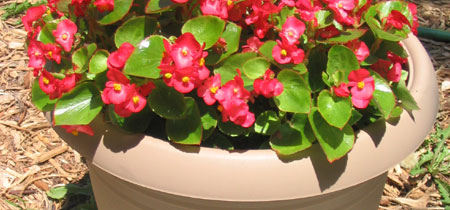Sarah Browning, Nebraska Extension Educator

Many gardeners have their own preferences regarding the choice of clay or plastic pots for their plants. If you do not have a firm opinion either way this article will detail some advantages and disadvantages of both types.
Clay Containers
Terra-cotta (unglazed clay) pots are made of a particular soil and fired in kilns during the manufacturing process. The rusty brown color of clay is harmonious with every flower and foliage color.
Clay pots provide a healthy environment for most plants. The porosity of clay allows air and moisture to penetrate the sides of the pot. This moisture and air is utilized by the fine roots located at the edge of the soil ball. Clay pots also act like a wick to remove excess moisture from the potting soil. This can be looked at as both an advantage and a disadvantage depending upon your watering habits.
Gardeners with a heavy hand at watering tend to over-water; their plants will probably benefit from clay. Other gardeners who wait for the wilting signal from their plants are better off with plastic. Plants which demand a well-drained, dry soil like cacti also prefer clay pots.
Outdoor usage of clay also has advantages. Clay pots have thick walls that protect plant roots from rapid changes in temperature which can be destructive. They also have a fair amount of weight and do not blow over as easily as some plastic pots. Clay does have the disadvantage of drying quickly. This can be a problem for moisture loving plants such as ferns or when attempting to germinate seeds.
Clay also has the tendency to form a white crusty layer on the outside of the pot. This is formed when mineral salts dissolved in the water are wicked from the potting medium into and through the pot wall. Some find this layer attractive, most gardeners find it unsightly. The salt deposits can be scrubbed off if their appearance offends. A final disadvantage, clay is easily broken.
Plastic Containers
Plastic pots are lightweight, strong and flexible. They are available in every color of the rainbow to coordinate with interior and exterior decor. Plastic does not have the wicking action that clay has making them an excellent choice for moisture-loving plants or for those gardeners who water infrequently.
Plastic pots are made of inert materials and are considered safe for growing plants. Many are made of recyclable plastic so disposal is environmentally friendly when the pot is no longer usable (unglazed clay pots are fully recyclable as well). Plastic pots generally have thinner walls than their clay counterparts offering roots little if any insulation from temperature change. Black plastic can actually act as a solar collector, heating up the potting medium to plant damaging levels.
If plants in dark colored plastic containers wilt quickly, check to make sure the plants are well watered then move them to a shadier location where heat build-up should not be a problem. Sunlight can be hard on plastic causing fading and brittleness. Many plastic pots intended for outdoor use are treated with ultraviolet light inhibitors to reduce fading and maintain flexibility thus increasing the life-span of the pot.
Whether it be plastic or clay, make sure the pot you select has drainage holes in the bottom to prevent over-watering.